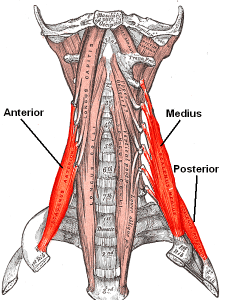Indications:
Thoracic Outlet Syndrome
Cautions:
This technique should be pain-free. It is effective so you don’t need to do it more than several times on each side.
Technique:
Have your client lying on their side with their head resting on the table (no pillow or arm under their head).
Sit behind them and with your outside hand bring their shoulder toward their ear. This takes up slack for the next step.
With your inside hand hook your fingers around the top of their clavicle near the sternum and pull back.
Lean back pulling their shoulder inferiorly while sliding your fingers out toward the acromioclavicular joint. Your intention is to work into the area around the first and second ribs where the scalenes attach.
Now do this same technique, but starting with your client’s head turned toward the ceiling. Have your client slowly turn their head toward the floor while you lean back pulling their shoulder inferiorly while sliding your fingers out toward the acromioclavicular joint. Time it so you reach the AC joint when your client’s head is turned toward the floor.
This technique works into the scalene attachments while the scalenes are being stretched.
Anatomy of the Scalenes
The word scalene comes from the Latin scalenus and means uneven, unequal, or having unequal sides. The three scalene muscles are of unequal lengths. If you remember your geometry you would know a scalene triangle has unequal sides.
The scalene muscles are deep muscles in the neck connecting the transverse processes of the cervical vertebrae to the first and second rib. They help to raise the upper two ribs, helping with inspiration.
The brachial plexus (the nerve supply for the upper extremity) passes in between the scalenus anterior and scalenus medius. In some people, there is an anatomical variation in which parts of the brachial plexus may actually pass through scalenus anterior.
The scalene muscles are often strained in whiplash accidents. When the scalene muscles are tight they can put pressure on the nerves to the upper extremity causing Thoracic Outlet Syndrome.
The thoracic outlet is the area in between the clavicle and the upper two ribs. Nerves and blood vessels for the upper extremity pass through this space and may be impinged. Impingement of the brachial plexus may be from tight scalenes, or may be from pinching between the first rib and clavicle when the scalenes pull the first rib into the clavicle.
Common symptoms of Thoracic Outlet Syndrome (TOS) are:
Pain, tingling or numbness down the medial side of the arm going to the 4th & 5th fingers (C8 dermatome).
The arm goes to sleep at night or when held overhead.
The radial pulse diminishes when the arm is held overhead
When working with nerve entrapment it is important to begin at the proximal ends of the nerves and release any restrictions before working with the more distal areas of entrapment. When there is pain, tingling or numbness into the arm the following areas may be sites of impingement and may be treated in the order shown.
Cervical nerve roots
Scalenes
First Rib
Pectoralis Minor
Bicipital Aponeurosis
Pronator Teres
Flexor Retinaculum
Related Techniques:
Thoracic Outlet Syndrome
Soft Tissue Release – Scalenes
Soft Tissue Release – Pectoralis Minor
Scalene Stretch
Scalenes – Anatomy
First Rib Release
